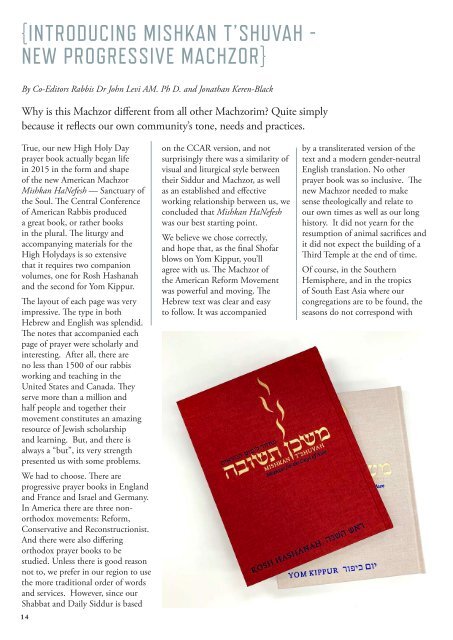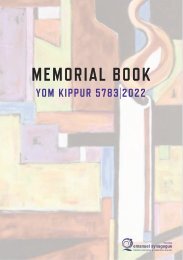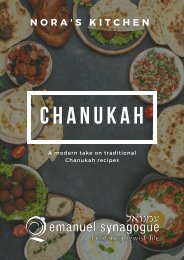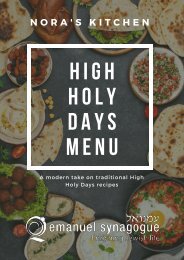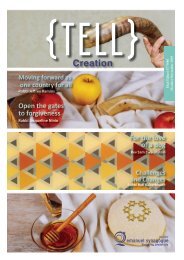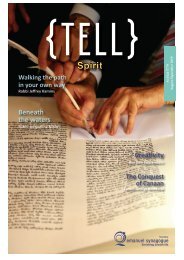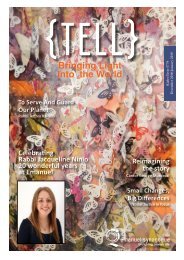TELL Magazine: October - November 2019
The magazine of Emanuel Synagogue, Sydney Australia
The magazine of Emanuel Synagogue, Sydney Australia
Create successful ePaper yourself
Turn your PDF publications into a flip-book with our unique Google optimized e-Paper software.
{INTRODUCING MISHKAN T’SHUVAH -<br />
NEW PROGRESSIVE MACHZOR}<br />
By Co-Editors Rabbis Dr John Levi AM. Ph D. and Jonathan Keren-Black<br />
Why is this Machzor different from all other Machzorim? Quite simply<br />
because it reflects our own community’s tone, needs and practices.<br />
True, our new High Holy Day<br />
prayer book actually began life<br />
in 2015 in the form and shape<br />
of the new American Machzor<br />
Mishkan HaNefesh — Sanctuary of<br />
the Soul. The Central Conference<br />
of American Rabbis produced<br />
a great book, or rather books<br />
in the plural. The liturgy and<br />
accompanying materials for the<br />
High Holydays is so extensive<br />
that it requires two companion<br />
volumes, one for Rosh Hashanah<br />
and the second for Yom Kippur.<br />
The layout of each page was very<br />
impressive. The type in both<br />
Hebrew and English was splendid.<br />
The notes that accompanied each<br />
page of prayer were scholarly and<br />
interesting. After all, there are<br />
no less than 1500 of our rabbis<br />
working and teaching in the<br />
United States and Canada. They<br />
serve more than a million and<br />
half people and together their<br />
movement constitutes an amazing<br />
resource of Jewish scholarship<br />
and learning. But, and there is<br />
always a “but”, its very strength<br />
presented us with some problems.<br />
We had to choose. There are<br />
progressive prayer books in England<br />
and France and Israel and Germany.<br />
In America there are three nonorthodox<br />
movements: Reform,<br />
Conservative and Reconstructionist.<br />
And there were also differing<br />
orthodox prayer books to be<br />
studied. Unless there is good reason<br />
not to, we prefer in our region to use<br />
the more traditional order of words<br />
and services. However, since our<br />
Shabbat and Daily Siddur is based<br />
14<br />
on the CCAR version, and not<br />
surprisingly there was a similarity of<br />
visual and liturgical style between<br />
their Siddur and Machzor, as well<br />
as an established and effective<br />
working relationship between us, we<br />
concluded that Mishkan HaNefesh<br />
was our best starting point.<br />
We believe we chose correctly,<br />
and hope that, as the final Shofar<br />
blows on Yom Kippur, you’ll<br />
agree with us. The Machzor of<br />
the American Reform Movement<br />
was powerful and moving. The<br />
Hebrew text was clear and easy<br />
to follow. It was accompanied<br />
by a transliterated version of the<br />
text and a modern gender-neutral<br />
English translation. No other<br />
prayer book was so inclusive. The<br />
new Machzor needed to make<br />
sense theologically and relate to<br />
our own times as well as our long<br />
history. It did not yearn for the<br />
resumption of animal sacrifices and<br />
it did not expect the building of a<br />
Third Temple at the end of time.<br />
Of course, in the Southern<br />
Hemisphere, and in the tropics<br />
of South East Asia where our<br />
congregations are to be found, the<br />
seasons do not correspond with


